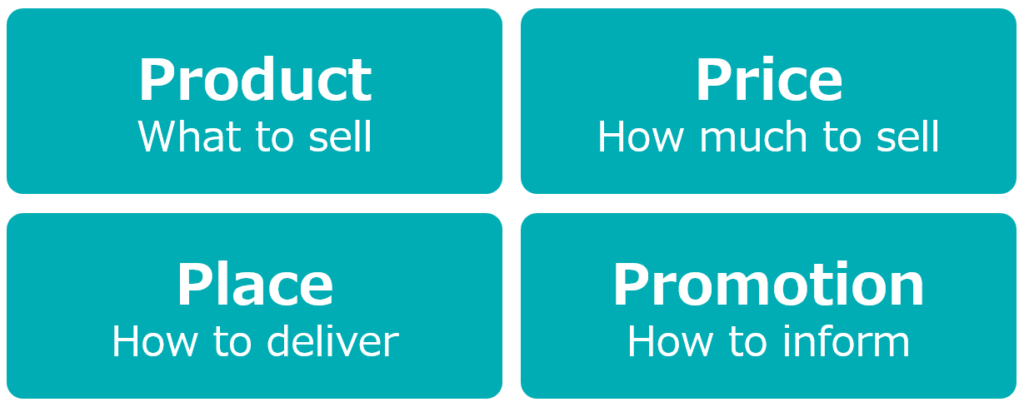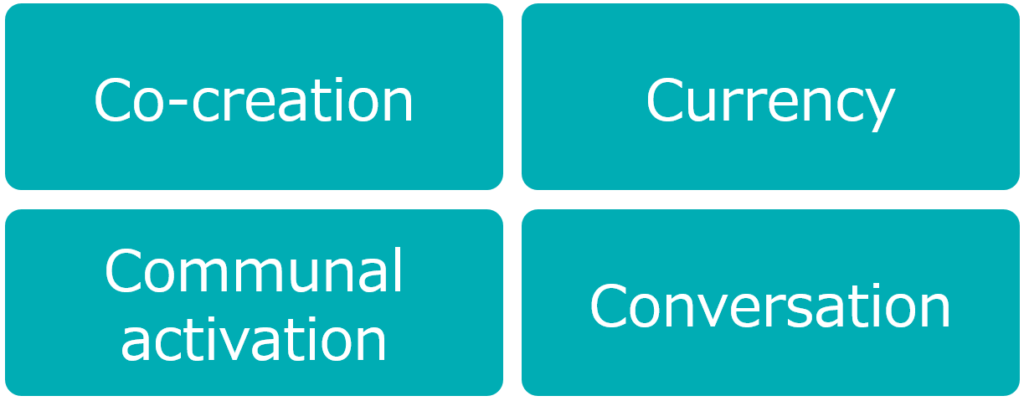The marketing mix is an important concept in planning what products and services a company will offer to its customers and how it will offer them. Product development has typically been based on customer needs and wants to be identified through market research, and much of the product development from conception to production has been controlled by the company. In the digital economy, however, a new trend is emerging in which companies are creating products together with their customers, rather than developing them unilaterally.

Contents [hide]
What is the 4P marketing mix?
First, let’s look at what the “4Ps” of the marketing mix are.

The 4P marketing mix consists of four “Ps”
- Product
- Price
- Place
- Promotion
When developing a product, a company must decide what to offer (what kind of “product” and at what price), how to “distribute” it, and how to “promote” it. If these four “Ps” are optimally designed and well-coordinated, customers will be drawn to the value proposition and sales will be more likely to follow.
This was a product-oriented and product-sales-oriented concept based on the 4Ps, which, from the company’s point of view, was product-centric marketing with an emphasis on product management. However, in today’s customer-connected world, the concept of the marketing mix has evolved to accommodate expanded opportunities for customer participation.
What is the 4C marketing mix?

The 4C marketing mix consists of four “Cs”
- Co-creation
- Currency (Dynamic pricing)
- Communal activation
- Conversation (Communication through conversation)
In the digital economy, co-creation, which involves listening to customers and creating products together, is emerging as a new product development strategy. Involving customers from the product concept stage will increase the success rate of product development and create a superior value proposition.
Pricing is also evolving from the previously constant standard pricing to dynamic pricing*. Advances in technology will extend this approach to online retailing. Based on various elements of customer profiles from big data, different prices can be set for different customers. In the digital economy, prices will be like a currency that constantly fluctuates according to supply and demand conditions.
*dynamic pricing, in which flexible prices are set based on supply and demand, is a technique that has been used for some time for hotels and airline tickets.
The concept of sales channels is also undergoing significant change due to digital. The development of the sharing economy has led to the rise of peer-to-peer*, and just as tech companies such as Airbnb and Uber have taken their toll on the existing hotel and cab industries, these new business model companies are offering customers easy access to products and services that are owned by other companies. products and services that are owned by other companies and made easily available to their customers.
*Peer-to-peer is a term used primarily in computers. It refers to communication between peers (on an equal footing) and is an image of direct communication between client terminals, rather than a principal-subordinate relationship between server and client terminal. In this case, it refers to the direct connection and interaction between users on a platform provided by a tech company.
In the digital economy, customers can immediately purchase or use a product or service when they want it. In other words, they can immediately use something that others own, even if they do not own it. This is called co-activation.
The concept of promotion is also changing. In the past, companies sent out one-way messages, but with the development of social media, customers can now respond to those messages. Customers can now respond to those messages, and can even engage in conversations with other customers. Advertisements are also praised and criticized. How we communicate with our customers is becoming very important.
Let’s shift product development from 4P to 4C
As described above, we are in an era in which companies must change their marketing mix from 4P to 4C. Companies will be able to adapt to the times by considering product and service development based on the 4Cs.
It is important to note that digital marketing is not a replacement for traditional marketing; the two approaches have their roles in the customer journey and should coexist, with traditional marketing playing a major role, especially in building awareness and interest, and digital marketing becoming more important as customers seek closer relationships with companies. Traditional marketing plays a particularly important role in building awareness and interest, while digital marketing becomes more important as customers seek a closer relationship with the company. Given the unique characteristics of each approach, Marketing 4.0 is all about capturing offline and online behavior in an integrated manner.

